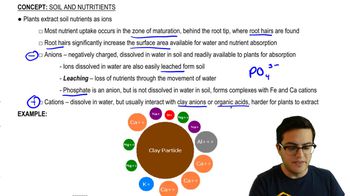Table of contents
- 1. Introduction to Biology2h 42m
- 2. Chemistry3h 40m
- 3. Water1h 26m
- 4. Biomolecules2h 23m
- 5. Cell Components2h 26m
- 6. The Membrane2h 31m
- 7. Energy and Metabolism2h 0m
- 8. Respiration2h 40m
- 9. Photosynthesis2h 49m
- 10. Cell Signaling59m
- 11. Cell Division2h 47m
- 12. Meiosis2h 0m
- 13. Mendelian Genetics4h 44m
- Introduction to Mendel's Experiments7m
- Genotype vs. Phenotype17m
- Punnett Squares13m
- Mendel's Experiments26m
- Mendel's Laws18m
- Monohybrid Crosses19m
- Test Crosses14m
- Dihybrid Crosses20m
- Punnett Square Probability26m
- Incomplete Dominance vs. Codominance20m
- Epistasis7m
- Non-Mendelian Genetics12m
- Pedigrees6m
- Autosomal Inheritance21m
- Sex-Linked Inheritance43m
- X-Inactivation9m
- 14. DNA Synthesis2h 27m
- 15. Gene Expression3h 20m
- 16. Regulation of Expression3h 31m
- Introduction to Regulation of Gene Expression13m
- Prokaryotic Gene Regulation via Operons27m
- The Lac Operon21m
- Glucose's Impact on Lac Operon25m
- The Trp Operon20m
- Review of the Lac Operon & Trp Operon11m
- Introduction to Eukaryotic Gene Regulation9m
- Eukaryotic Chromatin Modifications16m
- Eukaryotic Transcriptional Control22m
- Eukaryotic Post-Transcriptional Regulation28m
- Eukaryotic Post-Translational Regulation13m
- 17. Viruses37m
- 18. Biotechnology2h 58m
- 19. Genomics17m
- 20. Development1h 5m
- 21. Evolution3h 1m
- 22. Evolution of Populations3h 52m
- 23. Speciation1h 37m
- 24. History of Life on Earth2h 6m
- 25. Phylogeny2h 31m
- 26. Prokaryotes4h 59m
- 27. Protists1h 12m
- 28. Plants1h 22m
- 29. Fungi36m
- 30. Overview of Animals34m
- 31. Invertebrates1h 2m
- 32. Vertebrates50m
- 33. Plant Anatomy1h 3m
- 34. Vascular Plant Transport1h 2m
- 35. Soil37m
- 36. Plant Reproduction47m
- 37. Plant Sensation and Response1h 9m
- 38. Animal Form and Function1h 19m
- 39. Digestive System1h 10m
- 40. Circulatory System1h 57m
- 41. Immune System1h 12m
- 42. Osmoregulation and Excretion50m
- 43. Endocrine System1h 4m
- 44. Animal Reproduction1h 2m
- 45. Nervous System1h 55m
- 46. Sensory Systems46m
- 47. Muscle Systems23m
- 48. Ecology3h 11m
- Introduction to Ecology20m
- Biogeography14m
- Earth's Climate Patterns50m
- Introduction to Terrestrial Biomes10m
- Terrestrial Biomes: Near Equator13m
- Terrestrial Biomes: Temperate Regions10m
- Terrestrial Biomes: Northern Regions15m
- Introduction to Aquatic Biomes27m
- Freshwater Aquatic Biomes14m
- Marine Aquatic Biomes13m
- 49. Animal Behavior28m
- 50. Population Ecology3h 41m
- Introduction to Population Ecology28m
- Population Sampling Methods23m
- Life History12m
- Population Demography17m
- Factors Limiting Population Growth14m
- Introduction to Population Growth Models22m
- Linear Population Growth6m
- Exponential Population Growth29m
- Logistic Population Growth32m
- r/K Selection10m
- The Human Population22m
- 51. Community Ecology2h 46m
- Introduction to Community Ecology2m
- Introduction to Community Interactions9m
- Community Interactions: Competition (-/-)38m
- Community Interactions: Exploitation (+/-)23m
- Community Interactions: Mutualism (+/+) & Commensalism (+/0)9m
- Community Structure35m
- Community Dynamics26m
- Geographic Impact on Communities21m
- 52. Ecosystems2h 36m
- 53. Conservation Biology24m
35. Soil
Soil and Nutrients
Problem 6`
Textbook Question
A mineral deficiency is likely to affect older leaves more than younger leaves if
a. The mineral is a micronutrient
b. The mineral is very mobile within the plant
c. The mineral is required for chlorophyll synthesis
d. The mineral is a macronutrient
 Verified step by step guidance
Verified step by step guidance1
Understand the concept of mineral mobility in plants: Minerals that are mobile can be transported from older leaves to younger leaves when there is a deficiency.
Identify the characteristics of mobile minerals: Mobile minerals are typically those that can be relocated within the plant to support new growth, often affecting older leaves first.
Consider the role of older leaves: Older leaves may show deficiency symptoms first if the plant reallocates mobile minerals to younger, growing tissues.
Analyze the options: Determine which option describes a scenario where older leaves are affected due to mineral mobility.
Conclude based on mobility: The correct answer will be the one that indicates the mineral is mobile, as this would lead to older leaves showing deficiency symptoms first.
 Verified video answer for a similar problem:
Verified video answer for a similar problem:This video solution was recommended by our tutors as helpful for the problem above
Video duration:
3mPlay a video:
Was this helpful?
Key Concepts
Here are the essential concepts you must grasp in order to answer the question correctly.
Mineral Mobility in Plants
Mineral mobility refers to the ability of a mineral to move from older to younger tissues within a plant. Mobile minerals, such as nitrogen, phosphorus, and potassium, can be relocated to new growth areas when there is a deficiency, often affecting older leaves first. Understanding mineral mobility helps explain why older leaves show deficiency symptoms before younger ones.
Recommended video:
Guided course

Land Plants - 2
Role of Minerals in Chlorophyll Synthesis
Chlorophyll synthesis is crucial for photosynthesis, and certain minerals like magnesium and iron are essential for this process. A deficiency in these minerals can lead to chlorosis, where leaves turn yellow due to insufficient chlorophyll. If a mineral required for chlorophyll synthesis is deficient, it can significantly impact plant health and growth.
Recommended video:
Guided course

Food and Feeding
Macronutrients vs. Micronutrients
Macronutrients are nutrients required by plants in larger quantities, such as nitrogen, phosphorus, and potassium, while micronutrients are needed in smaller amounts, like iron, manganese, and zinc. Both types are vital for plant growth, but their required quantities and roles differ. Understanding the distinction helps in diagnosing and addressing nutrient deficiencies in plants.
Recommended video:
Guided course

Soil Nutrients
Related Videos
Related Practice





















